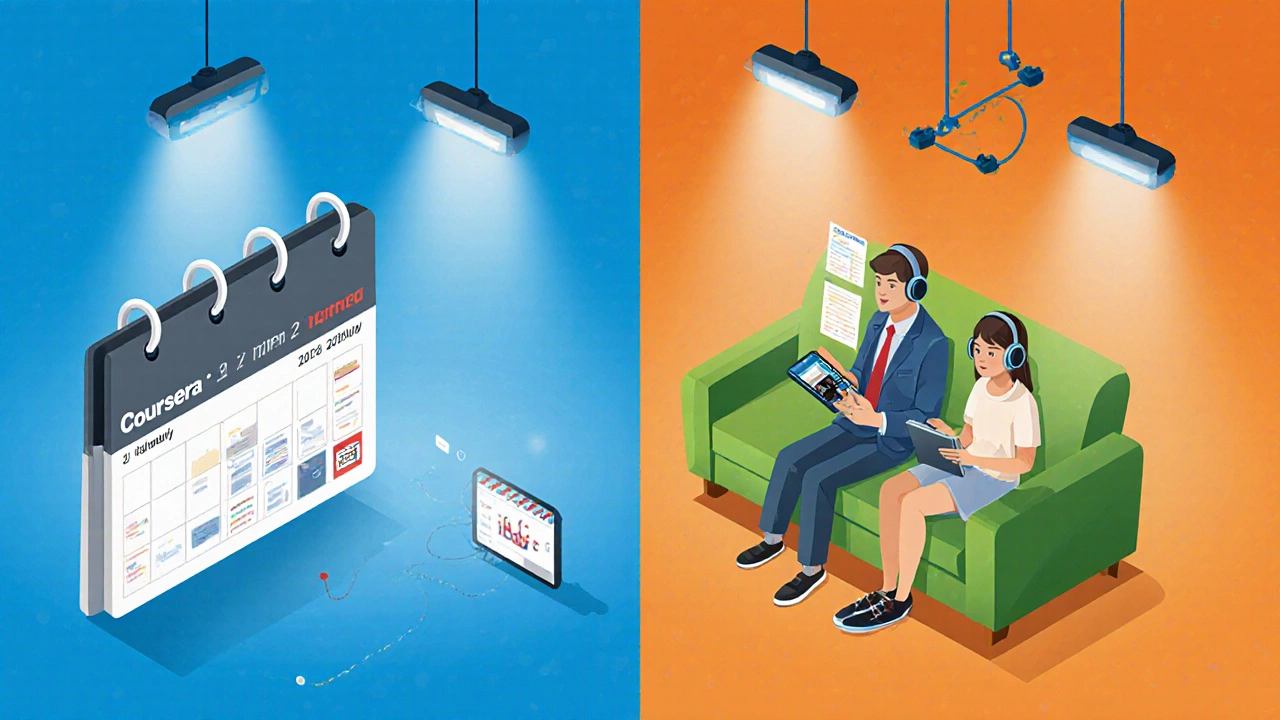
Coursera vs Udemy Decision Helper
Coursera
University-backed courses with accredited certificates and structured learning paths.
Accredited Credentials Structured LearningUdemy
Creator-driven marketplace with affordable, one-off courses and lifetime access.
Affordable Pricing Niche TopicsAnswer the questions above to get personalized recommendations on whether Coursera or Udemy is better for you.
Quick Take
- Coursera leans on university partners, offers accredited certificates, and bundles courses into specializations.
- Udemy is a creator‑driven marketplace, giving you cheap, one‑off courses with lifetime access.
- Pick Coursera if you need formal credentials, structured learning paths, or corporate‑grade content.
- Choose Udemy for hobby‑level skills, niche topics, or when you want to pay per course.
- Both platforms have mobile apps, subtitles, and community Q&A, but Coursera’s UI feels more "course‑like" while Udemy’s is more "store‑like".
When comparing Coursera a global online learning platform that partners with universities and companies to offer massive open online courses (MOOCs) and Udemy a marketplace where independent instructors sell on‑demand video courses, the decision often feels like choosing between a college campus and a local workshop. Both boast millions of users, but they serve different learning goals, budgets, and career stages. Below we break down every angle that matters in 2025 - from content breadth and pricing to credential value and post‑learning support - so you can answer the question with confidence.
What the platforms actually are
Coursera hosts courses created by accredited universities (Stanford, Yale, etc.) and top companies (Google, IBM). The content follows a semester‑style structure: weekly videos, quizzes, peer‑reviewed assignments, and sometimes a proctored exam. Many programs lead to a verified certificate, a professional‑level “Specialization”, or even a full online degree.
Udemy, on the other hand, is an open marketplace. Anyone can publish a course after meeting basic quality checks. The catalog is therefore far broader - you’ll find everything from "Intro to Space Law" to "DIY Sushi at Home". Courses are sold individually, and once bought you keep them forever.
Course catalog & variety
As of October2025, Coursera lists roughly 9,000 courses across 60+ subject areas. The platform emphasizes high‑impact fields like data science, business strategy, and health care. Because each course is vetted by an academic partner, you rarely see ultra‑niche topics - but you do get depth: a data‑science specialization might include five linked courses, a capstone project, and a final exam.
Udemy’s library tops 210,000 courses, making it the biggest consumer‑driven catalog on the web. The breadth is unmatched: you can learn how to play the ukulele, master the Python Flask framework, or get certified for "AWS Cloud Practitioner" - all under one roof. However, the depth varies; many courses are 1‑2 hour overviews rather than full programs.
Pricing models in 2025
Coursera offers three core pricing tiers:
- Free audit: watch videos, but no graded assignments or certificates.
- Subscription: $39-$79 per month for access to most Specializations and Professional Certificates.
- Degree programs: tuition ranges from $9,500 to $45,000 per year, paid per credit.
Udemy’s model is simple and per‑course: prices range from $9.99 during sales to $199 for premium content. Occasionally, Udemy for Business offers a corporate subscription (about $360 per user per year) that unlocks a curated library.
In practice, Coursera’s subscription can be cheaper if you binge‑learn a whole specialization in a month, while Udemy shines when you just need a single skill quickly.
Credential value & accreditation
Coursera’s certificates carry the name of a university or a recognized industry partner. A "Google IT Support Professional Certificate" is listed on LinkedIn as a credential backed by Google’s hiring data. Some universities even allow you to transfer Coursera credits toward a full degree.
Udemy certificates are a badge of completion, not an accredited credential. Employers recognize the platform for its practicality, but the value sits more in the skill demonstration than an official stamp. If you need a credential that appears on a résumé next to a university degree, Coursera wins.
Learning experience: UI, mobile, community
Both platforms provide iOS, Android, and web apps with offline download. Coursera’s UI mirrors a traditional LMS: a progress bar, weekly schedule, and a "Gradebook" section. The experience feels like a semester, which helps learners stay on track.
Udemy’s interface is more like a video‑streaming service. Courses are listed as playlists, and you can jump between sections freely. The comment section doubles as a Q&A; however, there’s no built‑in peer grading.
Community support differs as well. Coursera includes discussion forums tied to each week, and many courses have teaching assistants who answer questions. Udemy relies on instructor‑provided Q&A threads and sometimes private Facebook groups, which can be hit‑or‑miss.

Instructor quality & production values
Coursera’s instructors are professors or industry experts whose content undergoes university‑level review. Production quality is usually high‑definition video, professional graphics, and captioning in 30+ languages.
Udemy’s instructor pool is democratized. Some creators are seasoned professionals with polished studios; others are hobbyists. Production value can range from studio‑grade to simple screen‑recordings. The platform does enforce a minimum rating (4.0 stars) and quality checks, but variability is inevitable.
Career services & skill pathways
Coursera offers "Career Hub" tools for certain professional certificates: resume builders, interview prep, and direct job‑matching with partner companies. The "Career Academy" tracks job‑ready skills and suggests next courses based on market demand.
Udemy provides a "Udemy for Business" learning analytics dashboard for employers, but individual learners get limited career support. Some courses include a “certificate of completion” that you can upload to LinkedIn, but there’s no built‑in job board.
Pros and cons at a glance
| Feature | Coursera | Udemy |
|---|---|---|
| Course source | University & corporate partners | Independent creators |
| Number of courses | ~9,000 | ~210,000 |
| Pricing model | Free audit / subscription / degree tuition | Pay‑per‑course (sale‑driven) |
| Credential value | University‑backed certificates, degree credits | Completion badge only |
| Learning path structure | Specializations, capstones, weekly schedule | Standalone courses, optional bundles |
| Career services | Job‑matching, resume tools (for select programs) | Minimal - mostly self‑service |
| Mobile app quality | Offline download, progress tracking | Offline download, simple playback |
Which platform fits your goals?
Goal: Earn a recognized credential - Coursera’s university‑partnered certificates and degree pathways are the clear winners. If you aim to list a credential on LinkedIn that hiring managers instantly recognize, the Coursera badge carries weight.
Goal: Learn a niche hobby - Udemy’s massive catalog means you’ll likely find a short, affordable class on that exact subject. The one‑off payment model also lets you own the content forever.
Goal: Upskill quickly for a job transition - Look for Coursera’s Professional Certificates (e.g., "Google Data Analytics") which include hands‑on labs and employer connections. If you need a fast, low‑budget boost, a high‑rated Udemy course on the same skill can do the trick, but you’ll have to verify the content yourself.
Goal: Follow a structured learning path - Coursera’s Specializations guide you from beginner to project‑ready, with weekly milestones. Udemy lets you cherry‑pick modules, which is great for custom curricula but lacks the built‑in progression.
Goal: Budget‑conscious learner - Udemy’s frequent sales (often 90% off) make it the cheapest route. Coursera’s subscription can be a bargain if you commit to multiple courses, but the overall cost remains higher for degree programs.
Decision checklist
- Do you need an accredited certificate? → Coursera
- Is the topic extremely niche or hobby‑oriented? → Udemy
- Do you prefer a semester‑style schedule? → Coursera
- Is one‑off pricing important? → Udemy
- Will you benefit from career‑service integrations? → Coursera
Next steps
If you’ve decided on Coursera, start with a free audit of a relevant specialization to gauge the teaching style. When you’re ready, switch to the monthly subscription to unlock graded assignments and the official certificate.
If Udemy feels like the right fit, filter courses by rating (4.5+ stars) and enrollment count (10,000+ students). Look for instructors who provide downloadable resources and a money‑back guarantee - that cushions you against low‑quality videos.
Regardless of platform, pair the online material with a real‑world project: build a portfolio site, analyze a dataset, or create a DIY product. That tangible output is what employers care about more than the platform name.
Frequently Asked Questions
Does Coursera offer free certificates?
No. Coursera’s free tier lets you audit videos, but a verified certificate requires payment - either through a subscription or one‑time fee per course.
Can I get a refund on Udemy courses?
Yes. Udemy offers a 30‑day money‑back guarantee if you’re unsatisfied, as long as you haven’t watched more than 30% of the total video length.
Which platform has better mobile learning features?
Both have solid apps, but Coursera’s offline download syncs with your progress bar and shows weekly deadlines, making it more suitable for structured study. Udemy’s app focuses on simple playback and speed control.
Do employers value Udemy certificates?
Some employers recognize Udemy courses for skill verification, especially when the instructor is a known industry expert. However, they generally carry less weight than Coursera’s university‑backed certificates.
Is it possible to switch from a Udemy course to a Coursera specialization?
You can certainly supplement a Udemy course with a Coursera specialization, but there’s no formal credit transfer. Treat them as complementary learning resources.
